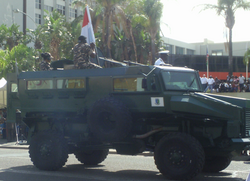Engineering:Wer’wolf MKII
| Wer’wolf MK2 | |
|---|---|
 | |
| Type | MRAP |
| Place of origin | Namibia |
| Service history | |
| Used by | Namibian Defence Force |
| Production history | |
| Manufacturer | Windhoeker Maschinenfabrik |
| Produced | 1998–present |
| Specifications | |
| Mass | 17,272 kilograms (38,078 lb)[1] |
| Length | 5,860 millimetres (231 in) |
| Width | 2,335 millimetres (91.9 in) |
| Height | 2,650 millimetres (104 in) without cupola 2,830 millimetres (111 in) with cupola |
| Crew | 2 |
| Engine | diesel |
| Power/weight | 13.5 kilowatts per tonne (18.4 PS/t)[2] |
| Suspension | 4x4 wheeled |
Operational range | 960 kilometres (600 mi) |
| Speed | 125 kilometres per hour (78 mph)[1] |
The Wer’wolf MK2 is a Namibian designed and built military vehicle that offers protection against small arms fire and land mines. The vehicle uses a MAN chassis, axles and engine. The Wer'Wolf MK2 is a modular vehicle. It is built with a crew compartment that seats three people plus a driver and a rear flatbed configuration. The flat bed configuration allows for different modules to be fitted. It is suited for rough terrain, in APC configuration the Wer'Wolf MK2 can carry up to 10 passengers plus the driver. Designed and built in 1998 it was the first Mine Protected Vehicle manufactured by Windhoeker Maschinenfabrik after it was bought by Government of Namibia.[3]
Design
The Wer'wolf MK2 was developed by Windhoeker Maschinenfabrik, a subsidiary of August 26 Holdings which in turn is wholly owned by the Government of Namibia. The vehicle utilizes a MAN Truck & Bus AG chassis, axle and engine and is built for the African operating environment. The modular design of the vehicle allows for the rear flatbed to be interchangeable with different mounts such as a personnel compartment, a ZU-23-2 gun mount amongst others. As with other typical Southern African mine protected vehicles of its era it also has monocoque V-shaped hull designed to deflect a mine blast away from the occupants or cargo. The Wer'wolf MK2 is in service with the Namibia Defence Force (NDF).
The Wer'wolf MK2 is 5,860 millimetres (231 in) in length, 2,335 millimetres (91.9 in) in width, and has a height of 2,650 millimetres (104 in).[3] The four-wheeled vehicle can carry up to 10 passengers in APC configuration, plus driver.[2] The crew compartment has two roof hatches which allow a gunner to use the weapon mount. The passenger APC compartment has an additional three hatches. Two doors in the rear of the vehicle provide access for the passengers and crew.
Capabilities
The Wer'wolf MK2 features ballistic protection that can withstand impacts of up to 7.62×51mm NATO rounds. The Wer'wolf MK2 also provides protection against triple anti tank mines of up to 21 kilograms (46 lb) under any wheel and can also withstand a double anti tank mine explosion 14 kilograms (31 lb) under the hull.[4] By adding an additional plate in the hull the vehicle can be protected against Explosively formed penetrator mines i.e.TMRP-6.[2] It has four-wheel drive capability, and can achieve a top speed of 125 kilometres per hour (78 mph). The Wer'wolf MK2 provides side protection from IED explosion of 14 kg of TNT from a stand-off distance of 3m.[1]
Variants
Apart from the primary APC role, the vehicle was designed for use in other roles such as:
- Ambulance[5]
- Anti aircraft Artillery role[5]
- Infantry Fighting Vehicle- A APC configuration armed with a 2A28 Grom 73mm gun.
- VIP transport[5]
- Freight logistics vehicle[5]
- Multiple Rocket launcher[5]
- Recovery vehicle[5]
- Water/ Diesel tanker[5]
- Riot control[5]
A variation of the Wolf MK2 called a HEC wolf has also been developed by WMF and Henrik Ehlers Consult (HEC).[6]
Operators
State actors
 Angola Fielded their units at exercise Amani Africa II in 2015.
Angola Fielded their units at exercise Amani Africa II in 2015. Democratic Republic of the Congo Some units were sold to the DRC army.
Democratic Republic of the Congo Some units were sold to the DRC army. Namibia It is the primary APC of the Namibian Army. The Namibian Police Force also operates units with the Special Field Force directorate.
Namibia It is the primary APC of the Namibian Army. The Namibian Police Force also operates units with the Special Field Force directorate. United States The United States Army Corps of Engineers had leased between three and nine units with Humanitarian Engineering Consulting CC (HEC) receiving commissioning fees in the deal.[7] Thereafter they bought at least four units.[8]
United States The United States Army Corps of Engineers had leased between three and nine units with Humanitarian Engineering Consulting CC (HEC) receiving commissioning fees in the deal.[7] Thereafter they bought at least four units.[8] Eswatini Unknown number of units were sold to Swaziland
Eswatini Unknown number of units were sold to Swaziland
Non-state actors
 Germany Used by German NGO Menschen gegen Minen (MgM).[1]
Germany Used by German NGO Menschen gegen Minen (MgM).[1]- Peshmerga Images of some units operated by the Peshmerga were uploaded to the internet[9]
 United Kingdom Aegis Defense Services A British private military c ompany was reported to have bought some units for use in Iraq.[10]
United Kingdom Aegis Defense Services A British private military c ompany was reported to have bought some units for use in Iraq.[10]
See also
- Casspir
- Buffalo (mine protected vehicle)
References
- ↑ 1.0 1.1 1.2 1.3 http://www.gichd.org/fileadmin/pdf/LIMA/MDE_Catalogue_2006.pdf
- ↑ 2.0 2.1 2.2 http://www.specops.pl/vortal/technika/wachowski/minoodporne_kto/Werwolf%20MK%20II.jpg
- ↑ 3.0 3.1 http://www.wmf.com.na/files/india_trial_report.pdf
- ↑ http://www.wmf.com.na/files/mine_report.pdf
- ↑ 5.0 5.1 5.2 5.3 5.4 5.5 5.6 5.7 http://www.specops.pl/vortal/technika/wachowski/minoodporne_kto/Werwolf%20MK%20II.jpg
- ↑ "HEC - Research Engineering Integration". ehlersconsult.com. 3 December 2002. http://www.ehlersconsult.com/Projects/HEC-WOLF/Wolf1.htm.
- ↑ Carin Pretorius - Developed CEIT Development CC. "The Namibian - Defence company sued (Economic news - )". The Namibian. http://www.namibian.com.na/indexx.php?archive_id=18842&page_type=archive_story_detail&page=5030.
- ↑ "NAMIBIA: Werewolf Sales". DeepDyve. https://www.deepdyve.com/lp/wiley/namibia-werewolf-sales-a9mAhkn9G3.
- ↑ http://kurdistanskyscrapers.com/topic/9346414/1/
- ↑ http://www.nshr.org.na/index.php?module=News&func=display&sid=788

